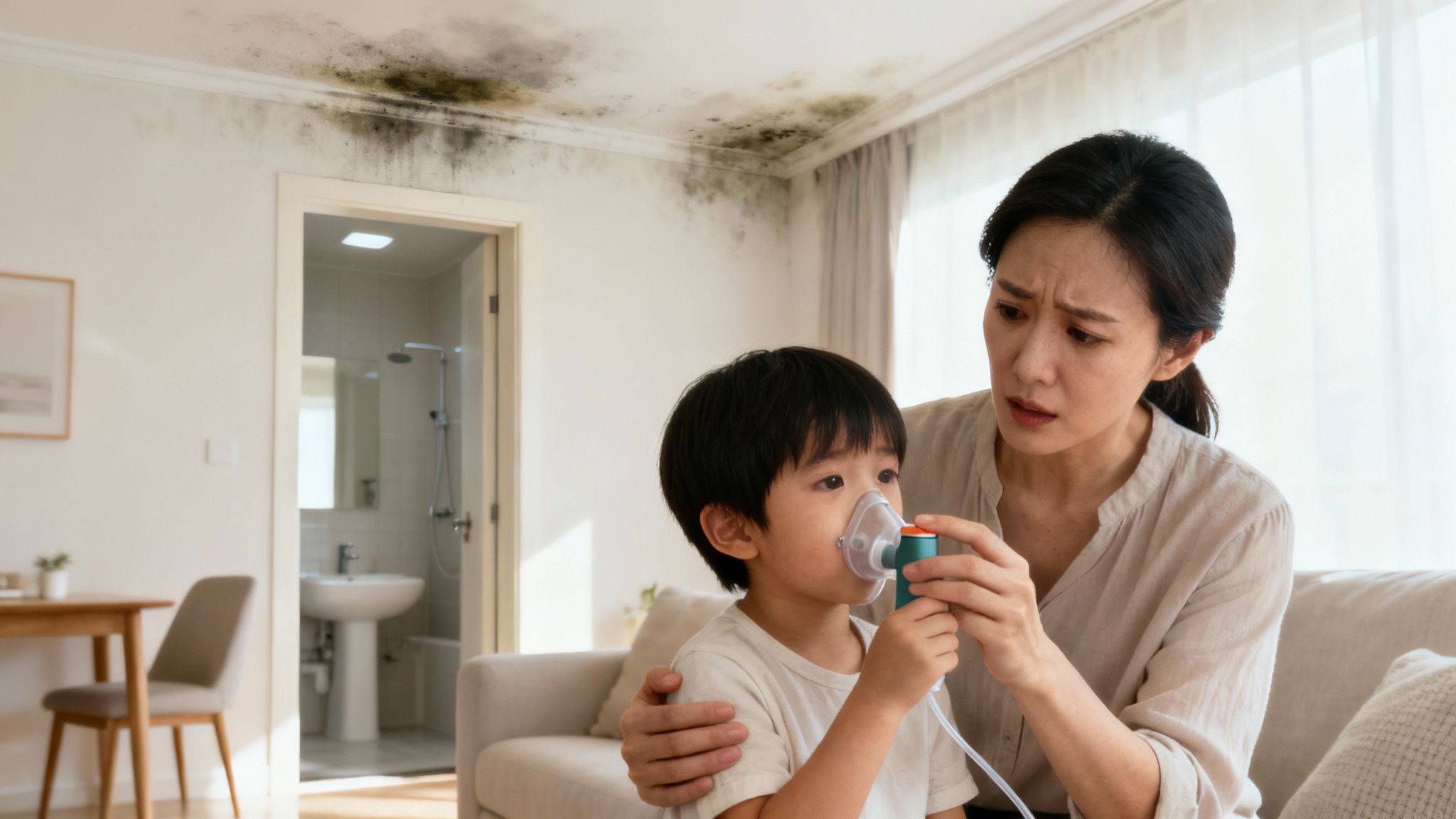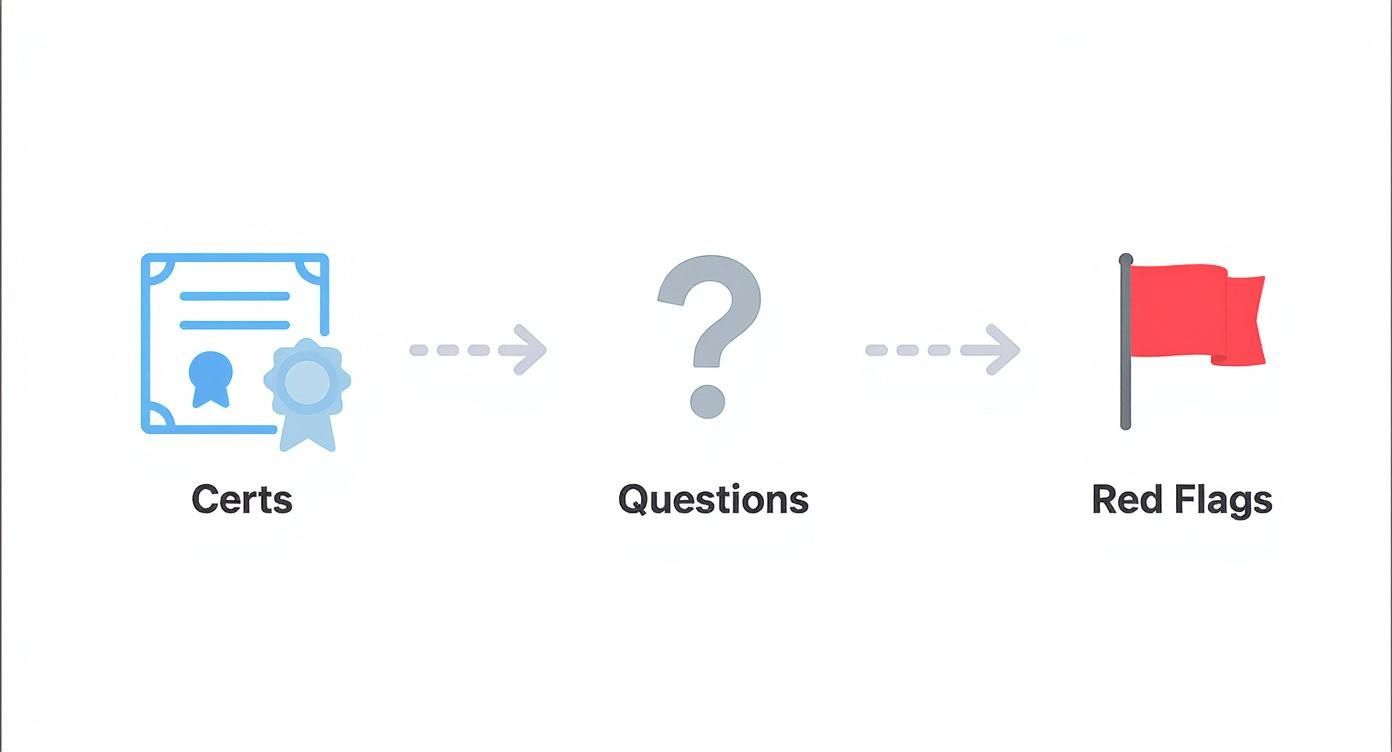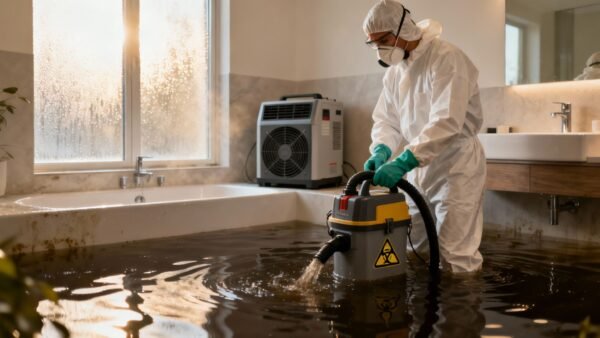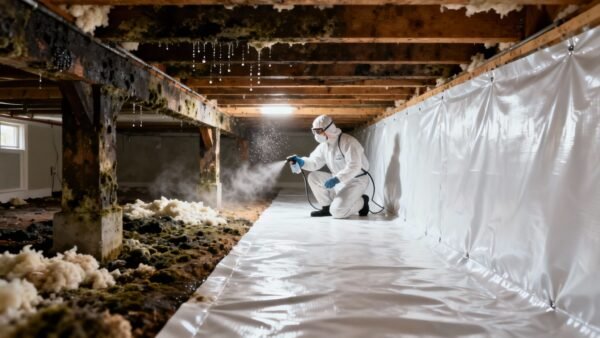When you discover a major mold outbreak in your home, especially after a leak, the first hour is absolutely critical. The right moves can stop spores from spreading throughout your entire property. The wrong ones? They can turn a manageable problem into a full-blown disaster that threatens both your home's structure and your family's health.
Your immediate priorities are simple but non-negotiable: stop the moisture source, isolate the contaminated area, and whatever you do, don't disturb the mold. This guide walks you through the immediate steps to take and explains why calling for professional emergency mold removal is the safest choice for your home and family.
If you're facing a mold crisis, don't wait. Call our 24/7 emergency team at (818) 336-1800 for immediate assistance.
Your First Moves in a Mold Emergency
Finding a wall covered in mold after a pipe bursts in Sherman Oaks or a basement floods from winter rains is a gut-punch. It's a race against the clock because mold can start growing in as little as 24-48 hours after materials get wet. How you react right now sets the tone for the entire cleanup process and protects both your property and your family's health.

What to Do Immediately
First thing's first: find and stop the water. If it's a busted pipe, you need to shut off the main water valve to your house right away. This is the single most important action in any water damage scenario. We cover these initial steps in more detail in our guide to emergency water cleanup.
With the water stopped, your next job is containment.
- Isolate the Area: Shut all doors leading into the affected room. If you can, grab some plastic sheeting and tape to cover any HVAC vents. This is a crucial step to keep mold spores from circulating through your home's ductwork.
- Limit Airflow: Resist the urge to turn on fans or open windows in that room. Any air movement can kick up millions of microscopic spores and send them airborne, contaminating other parts of your house.
- Stay Safe: Keep everyone out of the area, especially if anyone in your family has allergies, asthma, or a compromised immune system. If you absolutely have to go in, wear an N-95 mask and gloves at a minimum.
Common Mistakes to Avoid
Panic can lead to bad decisions. The biggest mistake we see homeowners make is trying to handle a serious mold problem themselves with whatever they have under the kitchen sink.
Do not spray bleach on the mold. This is a common myth. While bleach might kill surface mold on something non-porous like tile, it does absolutely nothing for porous materials like drywall or wood. It won't penetrate to the "roots," and the water in the bleach can actually feed the underlying mold. Plus, you'll be dealing with harmful fumes.
Also, don't touch, scrub, or try to wipe the mold away. Disturbing a mold colony is like hitting a dandelion puff—it sends countless spores flying everywhere. Your goal is to stabilize the situation until certified professionals can take over.
Mold Emergency Do's and Don'ts
When you're facing a mold crisis, it's easy to get overwhelmed. Here’s a quick-reference table to help you make the right choices in the heat of the moment.
| Action | What to Do (The 'Do's') | What to Avoid (The 'Don'ts') |
|---|---|---|
| Water Source | Immediately shut off the main water valve if it's a plumbing leak. Find and stop the source of moisture. | Don't ignore the water source. Cleaning mold without fixing the leak is pointless. |
| Containment | Close doors to the affected area. Cover HVAC vents with plastic and tape. | Don't turn on fans or open windows. This will spread spores everywhere. |
| Personal Safety | Wear an N-95 mask and gloves if you must enter the area. Keep children and pets away. | Don't enter the area without proper protection, especially if you have respiratory issues. |
| Cleaning | Leave it alone. Do not touch, scrub, or disturb the visible mold colonies. | Don't spray bleach or other household cleaners on the mold. It’s ineffective and can make things worse. |
| Airflow | Turn off your HVAC system to prevent spores from circulating through the house. | Don't run your central air or heat until the area has been professionally contained. |
| Professional Help | Call a certified mold remediation company as soon as possible. Document with photos. | Don't attempt a DIY cleanup for any area larger than a small patch. It's not worth the risk. |
Following these simple guidelines can dramatically reduce the spread of contamination and make the professional remediation process smoother and more effective.
Why Mold Growth Is a Health Emergency
What turns a simple patch of fuzzy growth into a genuine emergency? It's the very real risk mold poses to your health. While the damage to your property is a serious concern, the immediate threat to your family's well-being is what elevates a mold problem to a crisis. This isn't something you can put off until next weekend; it requires an immediate search for emergency mold removal near me.

Mold colonies don't just sit there; they release microscopic spores and mycotoxins into the air you and your family breathe. When inhaled, these particles can trigger a host of health issues, turning your home from a safe haven into a source of sickness. The effects can range from annoying to severe, and they often get worse over time.
From Annoying Symptoms to Serious Illness
The health impact of mold exposure can be sneaky. It might start with a persistent cough, itchy eyes, or a stuffy nose that you just can't shake. It's easy to write these off as seasonal allergies or a lingering cold. But often, these are the first signs that your body is fighting off an invader in your indoor air.
I’ve seen it happen time and again. A family might notice their child’s asthma is suddenly out of control, with more frequent attacks that aren't responding to their usual medication. More often than not, the culprit is a hidden mold colony, maybe growing behind the drywall from a slow, unnoticed leak in the bathroom.
The link between mold and health isn't just anecdotal. According to the U.S. Centers for Disease Control and Prevention (CDC), mold exposure can cause everything from stuffy noses to severe asthma attacks, hitting sensitive individuals the hardest.
Recognizing Early Warning Signs
Learning to spot the early clues is crucial. That distinct musty, damp smell—especially common in homes dealing with coastal fog in Santa Monica—is one of the biggest red flags. If you smell it, especially in places like basements or closets, it's often an indicator that you need an effective mildew remover for carpet and a deeper investigation. Don't ignore what your nose is telling you.
Pay attention to your body. If you or your family members are dealing with unexplained health issues that seem to get better when you leave the house, that’s a huge hint. It strongly suggests you need to start looking for mold.
While a DIY approach might seem appealing, it’s vital to use the right methods. For example, many people reach for bleach, but our guide explains why bleach isn't the answer for black mold. These persistent health problems are exactly why a quick search for "emergency mold removal near me" is one of the most important steps you can take to protect your family.
Knowing When to Call a Professional Mold Company
A tiny spot of mildew on your shower tile isn't a five-alarm fire. But knowing the difference between a small DIY cleanup and a serious contamination that needs an expert is one of the most important calls you can make as a homeowner.
Get it wrong, and you could turn a manageable problem into a structural nightmare with persistent health issues. So, how do you know when you’re out of your depth?
Red Flags That Demand an Expert
Some situations are non-negotiable. If you run into any of these, it's time to put down the sponge and pick up the phone. Don't hesitate.
- The Size of the Problem: The industry has a common-sense guideline called the 10-square-foot rule. If you’re looking at a patch of mold bigger than a 3-foot by 3-foot area, it's too large to tackle safely on your own.
- A Persistent Musty Odor: That strong, earthy smell you can't seem to air out? It's a massive red flag. Even if you don't see any visible mold, that odor almost always points to a hidden colony thriving behind drywall, under the floorboards, or deep inside your HVAC system.
- Contaminated Water Source: If the mold grew from a sewer backup or floodwater, stop immediately. That’s Category 3 "black water," a biohazard teeming with dangerous bacteria that requires specialized containment and disposal.
The Dangers of DIY Remediation
Trying to clean up a large mold problem yourself is a recipe for disaster. I've seen it happen countless times. Without professional-grade containment barriers and HEPA air filtration, you’ll disturb the colony and send millions of spores airborne.
This cross-contamination doesn't just spread the mold; it can expose your entire family to a much higher concentration of allergens and mycotoxins. You end up making the problem exponentially worse.
Professional mold remediation is more than just scrubbing a wall. It’s a scientific process involving containment, air purification, safe removal, and preventing regrowth. The industry is booming because people are finally understanding the serious health risks.
The global market for these services hit around USD 1.5 billion in 2024 and is expected to keep climbing as awareness grows. You can read more about the growth of the mold removal market here. This trend shows a clear shift: homeowners now see a professional mold remediation service not as a cost, but as a critical investment in their property’s value and their family’s well-being.
How to Find and Vet Local Mold Removal Experts
When you’re in the middle of a mold crisis, a fast search for "emergency mold removal near me" can feel overwhelming. You’ll get a long list of companies, and in a high-stress moment, how do you possibly choose the right one? It all comes down to vetting their credentials, asking the right questions, and knowing the red flags. Picking the wrong team can lead to sloppy work, a bigger mess, and a mold problem that comes right back.
The very first thing I look for is industry certification. A reputable company will have technicians certified by the IICRC (Institute of Inspection, Cleaning and Restoration Certification). This isn't just a fancy acronym; it proves they've been trained in the industry-standard protocols for safe and effective mold remediation. Without that certification, you’re basically rolling the dice.
Also, never, ever hire a company that isn't fully licensed and insured. Don't be shy—ask for proof of both general liability and workers' compensation insurance. If a worker gets hurt on your property and the company isn't covered, you could be the one held liable. It’s a risk not worth taking.
Key Questions to Ask Any Potential Contractor
Once you've confirmed their basic qualifications, it’s time to dig a little deeper. A true professional will have no problem answering your questions. In fact, they should welcome them.
- What is your containment strategy? They need to give you a clear plan. Listen for specifics like using physical barriers (plastic sheeting and zippers) and negative air pressure machines. This is critical for preventing spores from spreading through your entire home during the removal process.
- Do you use third-party, post-remediation testing? This is non-negotiable. An independent company—not their own guys—should come in after the job is done to test the air. This verifies that spore counts have actually returned to normal, safe levels.
- Can you provide a detailed, written estimate? A professional proposal should break down all the costs: labor, materials, and every specific procedure. Vague, one-line estimates are a huge red flag.
Asking these questions helps you quickly separate the real pros from the fly-by-night outfits. Our guide on choosing the right mold removal contractors offers even more tips to help you with this vetting process.
Crucial Red Flag: Be extremely wary of any company that offers to do both the mold testing and the remediation. This is a massive conflict of interest. A company that tests its own work has an incentive to either find a problem that isn't there or cut corners on the cleanup.
Spotting Common Scams and Subpar Practices
Finally, keep an eye out for companies pushing a one-size-fits-all solution. If someone suggests "fogging" your entire house with chemicals without finding the source, run. This approach doesn't address the root cause of the mold and is often completely ineffective. Real remediation involves physically removing the contaminated materials and fixing the moisture problem for good.
The mold abatement market is growing, which is good, but it has also led to a lot of inconsistent quality from some providers. As you search for help, remember that advanced tools like thermal imaging cameras and commercial-grade HEPA vacuums are signs of a well-equipped, modern company. The more you understand the industry's market trends and challenges, the better you'll be at spotting a quality contractor.
What to Expect During the Remediation Process
When you make the call for emergency mold removal near me, it’s completely normal to feel a bit anxious. Seeing professionals in full gear can be intimidating, but understanding their process helps demystify what’s happening in your home. It’s a systematic approach designed not just to clean up the visible mess but to restore your property to a safe, healthy state.
The first thing a certified team does upon arrival is a detailed assessment. They won’t just look at the mold you can see. They’ll pull out professional tools like moisture meters and sometimes even thermal imaging cameras to pinpoint the full extent of the water damage that’s feeding the growth. This initial inspection is critical because it creates a roadmap for the entire job, identifying hidden problem areas behind walls or under flooring.
Establishing a Safe Work Zone
Before a single piece of contaminated material is touched, the top priority is containment. You'll see the pros seal off the affected area from the rest of your home using thick plastic sheeting, often with zippered doorways. This creates an isolated work zone.
They’ll also set up negative air pressure machines. These are powerful units with HEPA filters that pull air from inside the contained area, scrub it clean of mold spores, and then vent it safely outside. This is a non-negotiable step to prevent cross-contamination and ensure spores don’t find a new home in an unaffected part of your house.
This visual guide shows a simple process for vetting the experts who will perform these critical tasks.

As you can see, your vetting process should be a three-step check: verifying certifications, asking detailed questions about their process, and watching out for any industry red flags.
Removal and Verification
With the containment zone secured, the physical removal begins. This isn’t a simple wipe-down. It involves carefully cutting out and bagging all mold-infested porous materials, like drywall, insulation, and carpeting. Hard, non-porous surfaces are meticulously cleaned with professional-grade antimicrobial agents.
Throughout this entire phase, you’ll hear HEPA air scrubbers running constantly, capturing any spores that get disturbed and kicked into the air during the removal process.
The final, and arguably most important, step is third-party clearance testing. A reputable company will insist that an independent environmental hygienist take air and surface samples after the job is done. This confirms that spore counts have returned to normal, safe levels. This unbiased verification is your ultimate proof that the remediation was a success.
Common Questions About Emergency Mold Removal
When you discover a mold emergency, a million questions race through your mind. The uncertainty can be just as overwhelming as the damage itself. Homeowners are always asking us about the timeline, the cost, and the process, so let's get you some clear, straightforward answers.
Q: How long does emergency mold removal take?
A: Honestly, it all comes down to the scale of the problem. If you catch a small patch from a leaky bathroom sink early, we can often wrap things up in just 1-3 days. That timeline covers setting up containment, carefully removing the affected drywall or vanity, cleaning the area, and making sure everything is bone dry. But if you're dealing with mold that has crept deep inside walls after a flood or has taken over a crawlspace, you’re looking at a much bigger project that can easily take a week or more. We will provide a clear, realistic timeline after our initial inspection.
Q: Is it safe to stay in my house during mold removal?
A: Your family's safety is the top priority. For smaller, isolated issues (like a single bathroom), you can usually stay, as professionals will seal off the area with containment barriers and negative air pressure machines. For large-scale contamination, especially if your HVAC system is affected or the work is in a central area, you will almost certainly need to find somewhere else to stay temporarily. This is a critical safety measure to avoid exposure to high concentrations of airborne spores.
Q: Will my homeowners insurance cover mold damage?
A: Insurance and mold can be a tricky combination. Most policies will cover mold removal if it’s the direct result of a "sudden and accidental" covered event, like a pipe bursting. However, they almost always exclude damage from slow, gradual leaks, poor maintenance, or high humidity. Knowing your specific policy is key. For a deeper dive, our guide on whether mold remediation is covered by insurance breaks it down in more detail. Always document everything with photos and call your agent right away.
Q: What is the difference between mold removal and remediation?
A: People use these terms interchangeably, but they mean very different things. "Mold removal" is simply the physical act of taking out visible mold. "Mold remediation" is the comprehensive professional process: containing the area, fixing the moisture source, safely removing all contaminated materials, cleaning the air with HEPA filters, and performing tests to verify your home is safe again. Always hire a certified company that performs full remediation. Anything less is just a temporary fix.
Don't let a mold problem get worse by waiting. Onsite Pro Restoration provides 24/7 emergency response to safely and effectively handle any mold crisis you're facing. Our IICRC-certified technicians are ready to restore your property and your peace of mind. Call us now at (818) 336-1800 or visit https://onsitepro.org to schedule an immediate inspection.





